|
Bristle/Fireworms (Errantiate Polychaete) Identification
FAQs
11 Related FAQs: Polychaete ID 1, Polychaete ID 2, Polychaete ID 3, Polychaete ID 4, Bristleworm ID 5, Bristleworm ID 6, Bristleworm ID 7,
Bristleworm ID 8,
Bristleworm ID 9,
Bristleworm ID 10, &
FAQs: Worm Diversity
FAQs, FAQs
2, FAQs 3, & Worm IDs
1, Worm IDs
2, Worm IDs 3, Worm IDs 4, Worm
IDs 5, Worm IDs 6, Worm IDs 7, Worm
IDs 8, & Worm ID FAQs by Group/Phylum: Flatworm Identification ID, Nemertean, Proboscis, Ribbon Worm ID,
Nematode, Roundworm ID,
Nematomorpha,
Horsehair Worm ID, Acanthocephalans,
Thorny-headed Worm ID, Tubeworm ID, Hirudineans, Leech ID, Sipunculids, Peanut Worm ID, Echiuran Worm ID, & Bristle/Fireworms 1, Bristle/Fireworms 2, Bristle/Fireworms 3, Bristle/Fireworms 4, Worm
Identification, Polychaete Behavior, Polychaete Compatibility, Polychaete System, Polychaete Selection, Polychaete Feeding, Polychaete Disease, Polychaete Reproduction,
Related Articles: Worms,
Polychaetes, Flatworms/Planaria ,
|
.jpg)
|
|
Long Worm ID 6/11/19
Hi Crew!
<Hey Danilo!>
I have one worm in my tank I am a little unsure of. I am leaning towards
guessing he is a bristleworm but just want to be absolutely certain. My little
28g nano tank is about 2 years old since I rebooted—very steadily growing and
overall it’s “happy” now.
<Ah good; and yes; this is an Errantiate Polychaete; one of many bristleworm
species>
He’s got to be at least 6–8 inches plus possibly, the mouth seems very small,
don’t see oversized pincers, and most of my critters don’t seem to be going
missing especially my tiger pistol and yellow watchman goby that share the
network of tunnels through the bottom with it, as I suspect they’d be the first
victims if it was overly aggressive.
<Mmm; yes; and I don't want to miss mentioning that you should be very careful
not to get "stuck" in the hand by those very sharp, glass-like podial spines
exiting from each body section>
In short, I just want to be sure I don’t have a baby bobbit. I do feed pretty
diversely everyday between pellets, sinking food, and liquid broadcast of oyster
and zooplankton. Maybe that’s why he’s so big?
<Yes to food being a factor. But/though some species are quite small, others
grow fast, to feet-size!>
I value all life so if he is beneficial or not overly dangerous I would prefer
to just leave him.
<Then do so; until, unless it poses a viable threat to your other desired
livestock>
I appreciate your feedback as always, have a happy day.
Dani Conner
<Thank you for sharing. Bob Fenner>
|
.jpeg) .jpeg) |
|
Possible bobbit worm 8/1/18
Hi
<Hi>
I found this today in a filter sock it is hard to picture as it’s small in
diameter and nearly a centimetre long but it appears to have the head to match a
bobbit but the head features are very small and almost transparent you can see
them near the eyes.
<It may be a Eunice Polychaete species but looks to me more like some sort of
Phyllodocid worm, both are predatory species.>
I have found a bobbit in my tank previously.
<And there may be more. Wilberth>
|
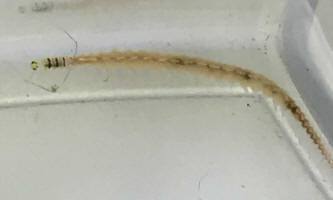 |
|
Worm type creature Id 8/1/18
Hi
<Hi Otilia>
I found this rapidly free swimming in a reef tank with very high flow.
It is about 1/4” or 6mm long
Are you able to I’d or tell me if it is safe to leave in tank
<Looks like some type of Polychaete worm, I wouldn´t worry, these worms feed on
detritus, just let it be.>
Thanks
<You´re welcome>
Otilia
<Wilberth>
|
 |
|
Polychaete identification help, photo attached
11/1/17
Hi crew,
<Edith>
I have been reading your archive of helpful answers on all things related to
bristle worms/Polychaetes/etc since I found 3 larger specimens in my 75 gallon
marine tank. I have photographed one, this one is new to me today.
(The other two I have been trying to get photos of but they sense any movement
and suck back under the rocks at lightning speeds.)
<Oh yes>
The one I am attaching a photo of is softer looking, and less scary while the
other two seem harder bodied, more officially segmented and have shorter firm
protrusions that may be "hairs?" These ones leave trails of slime and sand on
the sand bed each morning and stretch the length of the tank at times.
Any help with either identification is greatly appreciated. I will send a photo
of the other worms if/when I can get them on camera.
-Edith
<My best guess, as to family is Amphinomidae. Bob Fenner>
|
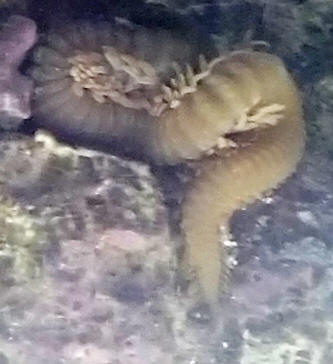 cropped, spiffed...
cropped, spiffed... |
|
Eunice ID 12/4/16
<Please crop your pic and re-send... See our guidelines. Your file is more
than an order of magnitude too big. B>
Re: Eunice ID
Apologies, hopefully the attached is okay and you can still see enough
detail? Nick
<? You didn't crop.... >
Subject: Eunice ID
Hi there Bob,
<Nick>
Sorry to bother you once again but I am approaching my wits end with this
hobby at the moment and have another question for you if you don't mind, I
was hoping you could clarify whether you think the worms in the attached pic
are juvenile Eunice worms?
<Might well be Eunicids>
After 1 week of attempted trapping I bit the bullet and destroyed one of my
rocks to remove a 4" Eunice this morning. After stirring up the tank
somewhat during the rock removal I found these 2 critters in my filter sock.
Looking at the antennae on the head I think I already know the answer but
was hoping you could give me a second opinion as to whether these are
Eunice. They are tiny at the moment (they were in a shot glass for the pic)
but I'm concerned I may have many many more of them.
<Mmm; well; IF they're not causing trouble....>
If these are indeed juv Eunice does that mean its likely I have another
larger specimen in addition to the one I removed?
<Possibly...>
Knowing I had gotten rid of what I thought was the only bobbit in the tank I
went and added a couple of very small Pterapogon kauderni and am now fairly
concerned they may be at risk.
<I'd use your trap once a month; and not worry (or try not to!)>
Thanks again
Nick
<Welcome. Bob Fenner>
|
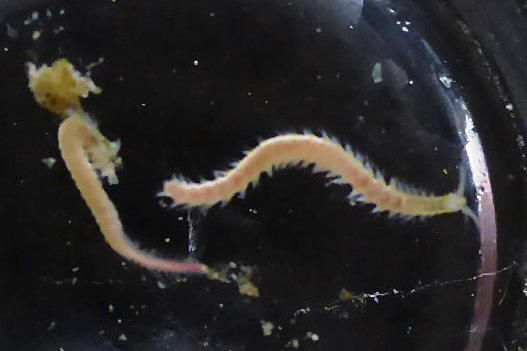 |
|
Re: Eunice ID 12/5/16
Ahh sorry please see attached for cropped version, that'll teach me to rush!
<Ah; thank you. I did crop and post>
I will definitely be using the trap regularly as you suggest and figure I
may take a two pronged approach by also employing the services of a
captive-bred Pseudochromis fridmani to help clear up the little ones.
<An excellent idea>
Can you offer any insight into whether captive bred Fridmani's still retain
the same instincts for hunting Polychaetes as their wild caught
counterparts?
<They do... and (of course) there are larger, even more eager bristle worm
predators... Arrow Crabs, bigger and bigger Labrids/Wrasses...
Tetraodontiform fishes if they'll go>
The only other fish in my 90g (48x18x24) are 2 x clowns, 2 x Kaudern's
cardinals and I have a captive bred coral beauty going in soon so I think
compatibility wise this should work (in theory!).
Regards
Nick
<And you, BobF>
|
|
Eunice Worm (Bobbit)
Hi, I have been trying to ID this Eunice worm to see if it is one that
will stay small, and I don't have to worry about it, or if I should make
more of an effort to remove it from the tank?
<I'd keep it; at least for now.... Interesting!>
This is the second one I've found since adding more Tonga branch rock to
my tank.
<Mmm; HUGE species can come in with live rock>
I was able to easily get the first one out, but this guy is just way too
fast, and I don't think a traditional type trap will work. For some
reason, the ones I've found in my tank seem to prefer the sand, I have
never seen one actually in the rockwork. I don't know if that means
anything as far as ID goes.
<Not to/for me>
Also, so far, they have been fairly easy to monitor, as they seem to
like building their burrow along the glass. This was about the best
photo I could get. I've watched the videos of some online, and I don't
know how they shine the light on them, and get film because as soon as
the light changes, mine is gone in a flash. Thanks for your time, and
help...it is
much appreciated. Y'all Rock!!!
<Thank you for sending this along (mon) Cheri... I have an olde but
extensive backgd. in Errantiate Polychaete ID (work for EIRs, EISs here
in S. Ca.); but can only assert that this does appear to be a member of
the genus Eunice. Need to really remove, (kill), preserve, examine such
worms closely (w/ a dissecting scope usually, or a good loupe)... A
useful key to subtaxa here:
http://www.boldsystems.org/index.php/TaxBrowser_Taxonpage?taxid=80788
Am going to post your pix, a drawing of a poss. related species on WWM
today, and send all along to Lynn Zurik, our keenest marine life
identifier, for her separate response. Bob Fenner>
|
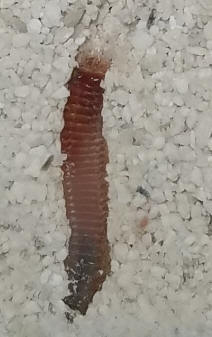
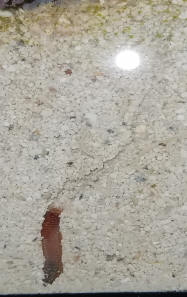
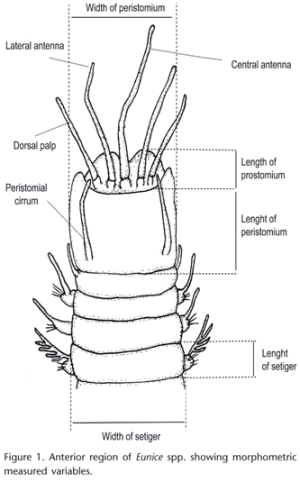 |
|
Re: Eunice Worm (Bobbit)
9/21/16
Thank you so much for the quick reply, and forward! I will do as you
suggest..just observe for now. I find it fascinating as to how fast it
rebuilds, and changes its burrow..it has had to a few times because of my
failed attempts at capture...lol
Cheri
<Really neat animals! Cheers Cher. BobF>
Re: Eunice Worm (Bobbit) 9/21/16
Oh, and thanks for the link...great photos and IDs.
Cheri
<Ahh! B>
Eunice Worm (Bobbit): Follow-up - 9/21/16
9/23/16
Hi,
<Hello Cheri, Lynn here this evening.>
I have been trying to ID this Eunice worm to see if it is one that will stay
small, and I don't have to worry about it, or if I should make more of an effort
to remove it from the tank? This is the second one I've found since adding more
Tonga branch rock to my tank. I was able to easily get the first one out, but
this guy is just way too fast, and I don't think a
traditional type trap will work.
<Probably not>
For some reason, the ones I've found in my tank seem to prefer the sand, I have
never seen one actually in the rockwork.
<Better to have it in the sand that in your coral. Some can cause real problems
there (boring into/through the coral).>
I don't know if that means anything as far as ID goes. Also, so far, they have
been fairly easy to monitor, as they seem to like building their burrow along
the glass. This was about the best photo I could get. I've watched the videos of
some online, and I don't know how they shine the light on them, and get film
because as soon as the light changes, mine is gone in a flash.
<Oh yes, indeed! I'm in complete agreement with Bob regarding this little
critter. I'd keep an eye on it, enjoy it, and only remove it if it becomes a
threat. Eunice worms have gotten a bit of a bad reputation and believe me, after
seeing videos of E. aphroditois in action, I get it! That is one heck of an
effective ambush predator! Thankfully, most of the little worms
we see in aquaria pose no real threat to livestock. In the case of Eunicids,
they range from being deposit-feeding detritivores, to feeding on coralline and
macro-algae, other Polychaete worms, Foraminiferans, carrion, and yep, larger
prey (as in the case of the above-mentioned creep-fest).
For right now, I'd go with innocent until proven guilty. >
Thanks for your time, and help...it is much appreciated.
<It was a pleasure, Cheri.>
Y'all Rock!!!
<Thanks! Take care, Lynn Zurik>
|
|
Unknown worm. 7/10/16
After a couple of years of happy reefing and not bothering you guys. I added
a new rock to my tank. And a couple of days later I noticed a worm in my
tank. Looked all over your site and haven't found one that matches.
About 2 foot long and about 1/4 inc in circumference. It has legs like a
centipede but they seem to point up and down. About every third one or so is
sticking up. The head end looks like a worm with a square shovel for a head.
I tried taking a picture but it sucked. I found one online accept that I
didn't see eyes on mine, but the shovel shaped extension is similar. Mine
might have been a bit more squared and thicker. I have seen it a couple of
weeks but I haven/t realized how big it was until it has migrated earlier
this week and it seemed to go on forever. But judging on where the head was
and the tail was its about 2 feet maybe more. It wasn't a concern until I
saw it bug my turbo snail earlier today. It didn't seen to have taken a bite
just poked it with the head end an than gave up after several attempts. I
attached a couple of pictures and a video. Hopefully it will all fit in your
inbox. Please let me know what you think it is and if I should try and get
it out. And if I do, should I wear some sort of protection. Thank you.
Artur.
<Hi Artur
Jordan with you tonight. Unfortunately you have an Oenone fulgida. A
particularly nasty predator that I'm all too familiar with. They
prey primarily on gastropods but I've seen them go after other inverts. They
are primarily nocturnal and it is odd that you saw one during the day. I
would take that as a sign that there are likely many more. I've had success
removing them with a PVC trap. Use an 8 or 9 inch piece of PVC capped with
removable ends. Drill a small hole in the pipe for the worms to enter. Bait
the trap using PE Mysid inside a mesh bag that is tied shut so they cannot
get to the bait. Place in the tank at lights out and pull in the morning.
Wear gloves as the worms produce a toxic mucus. Conus regius can be used to
keep numbers in check but it will prey on beneficial Polychaetes as well.>
|
.jpg)
.jpg) |
|
Re: Unknown worm. ID and Polychaete control 7/9/16
7/12/16
I have a healthy cleanup crew with many different worms. Will i be able to
separate the nasty one from the good stuff? If yes than what's the best way? If
not than how do i limit the amount of benign worms i have to throw away. Im
assuming that the thing was just looking for a new home because i have
transferred a rock from my friends tank in to mine recently. Or at least i hope
so. Dealing with an infestation of those things is not what i want to do. Thank
you for the quick response. <Hi Artur. I have limited saltwater experience but
have dealt with these things myself. Someone else with a better idea may chime
in here as well but I introduced a predatory specie that would remove them much
like a freshwater assassin snail would kill and consume nuisance snails. Conus
regious would be a wise choice. Like Jordan said there are likely many more. Id
use the PVC trap and depending on how large your system is I would consider
building 2. I inherited a 400 gallon system from my father with these ugly
little critters in it. I made 3 traps and introduced a small armada of 5 Conus
regious and it cleared them out of the system rather quickly. Feel free to
contact us anytime with anymore questions. Good luck. ~Ian>
re: Unknown worm.7/9/16
7/12/16
I had a crown conch before. It ate all of my snails. Its like fighting fire with
fire. Ill stick to the traps. Any sigestion<suggestion?> on the size? Do i need
to makw<make likely > it longer than the worm i intend to catch? What about the
width? I have some one inch pvc im not using, will that work? I got a 65 gallon
but its being overfed relygeously<...>. So my worms and copepods and stars are
probably enough to keep your 400 as clean as a wostle. I had a batch of 30
Turbos die in my sump about a month ago and the tank didn't even get phased. So
im assuming that even if i catch the really bad worms it will be accompanied by
about 100 of the good bristle worms and stars. Not to mention the copepods. Any
type of bait that the nasty creater will go for that others would not touch? I
don't want to decimate my cleaning crew in the process of catching the buggers.
<Please spell check before sending. Unfortunately that's the trick using bait as
it will attract a range of critters including the bad worms. I would use mysis
shrimp cubes fresh or frozen in a small mesh bag that they cannot get to or
consume. I'd use 2" diameter PVC pipe around a foot long. Check the trap
regularly and remember to wear protective gloves as these nasty things can and
will release a toxic mucus. Then I would empty it into a half full white 5
gallon bucket and if there are any beneficial creatures in there take them out
of the bucket and toss them back into your system. Dispose of the other
miscellaneous nuisances how you wish. ~Ian>
Re: Unknown worm. 7/13/16
Thank you l. Very much. (I type in multiple languages so i had to shut the
spell-check off. Sorry about that.)
<Very welcome. Best of luck to you. Ian>
|
|
What kind of worms are these?
4/5/15
Hi guys, i just got some Chaeto from a local store and noticed some
hitchhiking worms. A few small and 2 or 3 sizeable ones (1" or so length).
I'm guessing they are Fireworms based on coloration,
<Yes; Errantiate Polychaetes... several families are ID'd on WWM>
but want to clarify if they're harmless or if they're the predatory coral
eating Hermodice carunculata, before i introduce them to my reef sump.
Thanks in advance!
Josh
<Are predaceous on something/s... but if not too large or numerous... See
WWM re compatibility. Bob Fenner>
|
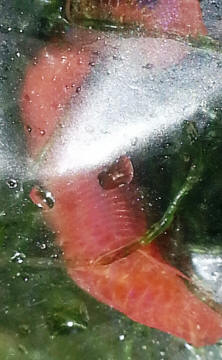
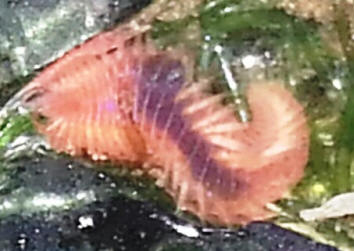 |
|
what is this creature? 12/2/14
i found a flatworm i removed it from the tank, then i looked at the same
spot the flat worm was (on Zoas) and there was something else i removed
it from the tank and took these 2 pix of it. the front and back of the
creature, it was moving almost looked like it was walking using the
spikes, look like it had a mouth or anus on the flat side edge where
there are no spikes.
<Yes; I agree; and a good clue>
it was about 2-3 cm in length, it was flat, slimy, no segments, i have
shown the pix every reef store in the phx az area and i have show it to
a Facebook marine society, i have spent countless hours Googling
everything from bristleworms to Nudibranchs, to cucumbers to flatworms.
i cant figure out what this creature is.. can you tell me? sincerely
Jill
<I do think this is an Errantiate Polychaete... a reproductive part...
epitoke.... The bristles/chaetae are definitive... Still, this is only a
guess. Thank you for sharing. Bob Fenner>
|
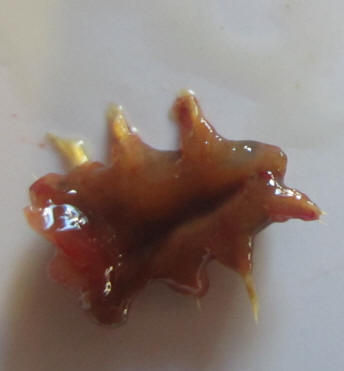
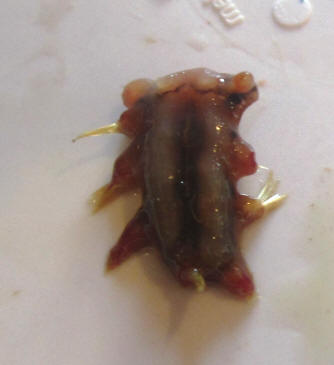 |
|
Is this Oenone fulgida?
5/26/14
Hello All,
<Tom>
I was hoping someone could help with a worm identification.
<Mmm; the Errantiate Polychaete in your pic>
I have a 55 gallon, fish only, with live rock, tank. It has been running for
close to two years now. Current residents include a pair of black and white
ocellaris (for about 1.5 years), one Salarias fasciatus (new in the last 3
months but doing very well) and one Lysmata amboinensis (added yesterday).
That and various clean-up crew members, bristle worms, and what I believe to
be several orange ball anemone (Pseudocorynactis). I have been experiencing
suspicious deaths in my tank for some time now. The crime scene has had
several characteristics in common. The first is a mucus like web that
encases the victim in question. The second is the location of the victim,
which has been near one rock in particular. Losses have included numerous
Florida and dwarf Ceriths and Nerite snails as well as several fish, most
recently my attempts at adding a dwarf angel. The last addition was a flame
angel from live aquaria. I decided not to quarantine this time (I know) as I
have not been having luck with the process. Meaning that they appear to do
well in quarantine but succumb after only a few days in my display.
The flame arrived and was not doing well from the start, alternating between
appearing normal and laying on the bottom of the bag on its side or upside
down. I acclimated over several hours and introduced it to my display.
Again it alternated between the two states of being. This morning I found it
deceased, in the bad part of town, encased in the mucus web being had for
breakfast by what I believe to be Oenone fulgida. I don't know if the flame
was dead before the worm got a hold of it or just weak and easy prey.
<Me neither>
After having done some research I decided to remove the host rock and dip it
in fresh ro water. This is what came out of the rock so far. (Best pic I
could get with my camera). Question one, is it Oenone fulgida?
<Might be>
Question
two, what are the chances I have more?
<There might well be>
I do have a healthy bristle worm population (I hope just bristle worms, they
are much thinner that this specimen and actually spend time out in the open
on the sand bed). My clowns and algae blenny have not been bothered by this.
Was it just being opportunistic or is it a true fish killer?
<Can't tell; but could well "cross the line" if hungry. Best to set a trap
or two, bait them out and remove. See WWM re Bristleworm Compatibility>
Thanks as always for all your sage advice.
Tom
<Sort of like the plants in the canyon out back; I agree (free and
aromatic). Bob Fenner>
|
 |
|
need help identifying worm 1/22/14
Hi Crew!
<Kristin>
First, love the site, really helps a lot! Second, I've Google searched
this so much and I still can find one that i think looks like the
pictures. Its in with my copepods in the mess they make, very small, but
visible to the eye. Brown in color, same as the copepods waste. I could
not see with visible eye that they had tiny leg like things.
<Yes; podia, parapodia...>
Under scope they do and a round head with interesting dark spot that i
don't think is eye spots and two points at the back of it. I just
want to make sure they aren't eating my pods, i think they're harmless
just bottom tank cleaners but I'd like a second opinion. I have not
noticed a decrease in pod population but these things are increasing in
population.
Thanks!
Kristin
<Epitoke phase... Errantiate Polychaete ("Bristleworm). Bob Fenner>
|
.jpg)
.jpg) |
Re: need help identifying worm
1/22/14
Thanks!
<Welcome>
I Google searched the Errantiate Polychaete and looked at your site, i got
this from your site...
"Errantiate Question 9/28/05 Hello,
<JackDan> I have a Marine Tank. I identified these worms in my tank as
"Errantiate" through your site.
<Ah... yes... a "higher taxonomic" category of Polychaete worms...
Sedentariate ones are tubiculous... make tubes, don't
move... Errantiate ones, as in "to err is human" (sort of) are mobile...
they move about> Now that I have
identified them, I'm having trouble finding out if they are good or not.
<Most are no problem. Larger ones, or too many
can become predaceous> "
if it gets big then I could have a problem... Since its so small I'm
assuming this one will not get huge and hurt things... Or could i be very
off and this thing could get pretty big? I will keep them separate and watch
them grow i guess to see how big they get.
<... can't tell "at this juncture": but I would not be concerned... There
are many species; large and small... but most won't/don't survive
metamorphosis/es in captivity. Likely "these too shall pass">
Will this guy be bad for my pods or my tank? Or is he just a scavenger that
will help clean things up? Don't want a predator if i can avoid it.
Kristin
<A distant possibility of concern. Again, don't panic. BobF> |
|
|

